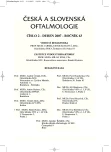The Influence of LASIK to the Retinal Nerve Fiber Layer in Myopia
Authors:
P. Hlaváčová; M. Horáčková; E. Vlková; M. Goutaib
Authors‘ workplace:
Oftalmologická klinika LF MU a FN, Brno Bohunice
prednosta prof. MUDr. E. Vlková, CSc.
Published in:
Čes. a slov. Oftal., 63, 2007, No. 2, p. 103-107
Overview
Purpose of this paper was to evaluate statistically the thickness of the retinal nerve fiber layer (RNFL) measured by means of the GDx analyzer in middle and high degrees of myopia before laser assisted in situ mileusis (LASIK) and in the postoperative period of 6 months.
Material and methods:
The group consisted of 35 eyes of 18 patients (8 men and 10 women), the average age was 28.9 ± 5.08 years of age. The refractive error was from -3.25 dioptres (D) to -11.5 D (average -5.5 ± 1.4 D). The patients underwent the corrective refractive procedure by means of LASIK to correct the myopia. The thickness of RNFL was measured by means of GDx analyzer with Variable Corneal Compensator before the refractive procedure and 3 and 6 months after this. Before each measurement, a new compensation of the cornea according to the actual refractive status was used. The RNFL thickness values (in μm) were compared and statistically evaluated using of the Wilcoxon’s nonparametric pair test in the whole peripapilary ellipse area (TSNIT) and in the superior and inferior quadrants of this ellipse.
Results:
Statistically significant difference of the RNFL thickness at the 5 % level of significance was found in the TSNIT area after 3 months and after LASIK. Statistically significant difference of the RNFL thickness at the 1 % level of significance was found in the superior quadrant after 3 months and in the inferior quadrant after 3 and 6 months after LASIK.
Key words:
LASIK, GDx, VCC analyzer, thickness of the RNFL
Labels
OphthalmologyArticle was published in
Czech and Slovak Ophthalmology

2007 Issue 2
Most read in this issue
- Intraoperative Floppy Iris Syndrome
- Orbital Apex Syndrome of the Aspergilus Ethiology – a Case Report
- The Cooperation between the Ophthalmologist and the Endocrinologist in the Treatment of the Endocrine Orbitopathy
- Functional Examination of Retinal Vessels in Patients with Central Retinal Vein Occlusion
